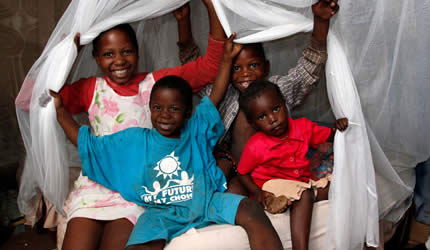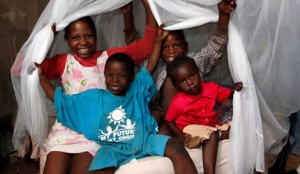
The Sunday Mail

 A mother frantically says her son’s name, again and again, in the half-empty acute-care room in a provincial hospital in western Kenya.
A mother frantically says her son’s name, again and again, in the half-empty acute-care room in a provincial hospital in western Kenya.
Her young boy is unconscious with malaria and lies on a bed pushed up against a wall, its paint faded and peeling.
When her son does not respond, she begins to softly pat his face with an open hand, desperately hoping to wake him up: “Kevin. Kevin. Kevin.” No response.
From the far corner of the room, a tired-looking nurse walks to the boy’s bedside. The nurse is one of only 17 nurses working in the paediatric ward of a hospital with a referral base of nearly six million people.
She looks at the boy briefly then focuses on comforting his mother.
Among the more than one million people malaria kills annually are hundreds of thousands of children. Most are under age five, their immature immune systems failing to control the aggressive disease.
The majority of these children are from the developing world. Almost 90 percent are from sub-Saharan Africa.
Killing children is not all malaria does.
Over the course of the past 4 000-plus years, this mosquito-borne disease has permeated human society.
Its effects are both far-reaching and complex.
According to the World Health Organisation (WHO), malaria threatens approximately 2 billion to 3 billion people, or roughly 40 percent of the world’s population, and inflicts approximately 500 million clinical attacks each year.
These attacks can result in severe complications during pregnancy and lead to maternal death or low infant-birth weight.
Data on malaria can be hard to obtain, but scientists reckon that the disease reportedly kills 71 000 to 190 000 infants in Africa annually.
It can leave victims cognitively disabled.
The malaria parasite also interacts with other afflictions, such as HIV and under-nutrition, in ways that are yet to be fully understood.
Economically, malaria drains the wealth of nations and households. Recently the WHO reported that malaria costs Africa US$12 billion a year.
In countries where this disease is endemic, it grinds down the per capita economic growth rate by 1,3 percent yearly.
Poor households can spend up to 34 percent of their total income fighting malaria, observed the WHO and the United Nations Children’s Fund.
All of these numbers paint a grim global picture, but what is perhaps most disturbing about these figures is that they have not improved over the last 10 years.
Despite eradication efforts during the 1950s and 1960s, an array of bold targets set at international conferences, and the Roll Back Malaria (RBM) programme with its extensive global partnership, this ancient disease continually finds new ways (such as drug-resistant parasites) to take the lives of some of the world’s most vulnerable.
Lately, however, there has been a handful of encouraging signs — including the RBM Partnership’s Global Strategic Plan announced in November 2005 — that this trend can be reversed.
“Right now there is about as much global interest in malaria as I’ve ever seen,” said Brian Greenwood of the London School of Hygiene and Tropical Medicine, who has spent nearly 40 years battling the disease.
“Can it be sustained? I don’t know. But it will need to be if we want to get anywhere in this fight.”
Robert W. Snow, of the Centre for Tropical Medicine at the University of Oxford, said a lack of reliable data on malaria, especially on malaria mortality, is an issue that jeopardises the credibility of the entire RBM mission.
He is not alone in worrying about this.
Amir Attaran, of the Institute of Public Health at the University of Ottawa, maintains that the RBM “targets were pulled out of thin air.”
“This is what happens when you set numbers as part of a political exercise. What do you think is going to happen when you set a random number as a target?
“Well, of course you are going to miss it. It’s a fanciful number,” he said. “The numbers were utter fantasy. Look, if you want to reach these sorts of numbers, if you want to actually achieve something on the ground against malaria, you need to pay to do it, you need the financing.”
As critics and supporters of the RBM movement point out, when funding flowed in the past to push back or eradicate this disease in the United States and Europe, it resulted in success. It was more than heaps of money that helped eradicate malaria from these places, however.
Climate played a major role in the victory, as did the type of mosquito, the strain of parasite and the countries’ general level of prosperity.
In the 1940s, the south of the US, Greece, Italy and Spain were all plagued by malaria.
These places, however, are in what is described as the “temperate or fringe areas of transmission.”
Neither the species of mosquito nor the malarial parasite it had teamed up with in these fringe areas could compare with the more aggressive varieties found in the tropics, especially in sub-Saharan Africa, experts insisted.
Cooler climate, low humidity and a lack of abundant rainfall result in less active mosquitoes and, therefore, reduce the rate of parasite delivery, according to entomologists.
When one adds to that the military zeal with which these “fringe countries” sprayed the insecticide dichloro-diphenyl-trichloroethane (DDT); the army of people they employed to drain breeding sites (the US hired 36 000 men to drain three million acres of swamp); the effectiveness of the antimalarials (drug-resistant parasites were not abundant); and the general level of wealth of the citizens, it becomes easy to understand why most eradication campaigns succeeded in the West.
“Unlike Africa and parts of Asia, Europe and North America had very different vectors (mosquitoes),” explained Mary Hamel, chief of the malaria branch at the Centres for Disease Control, Western Kenya
“They were not as resilient. On top of that, while these campaigns were going on in Europe and America, people’s socio-economic status improved. People were able to stay within their screened houses. They were able to afford treatment.”
In 1955, the WHO embarked on a global war against malaria. Hundreds of millions of dollars were spent during this campaign, which witnessed free DDT spraying — “the atomic bomb of the insect world” — on a massive scale and the development of new drugs.
The programme enjoyed some success but produced little change in the overall number of malaria cases.
Mosquitoes in places where malaria was entrenched even started to show resistance to insecticides. The eradication campaign was officially declared a failure in 1976.
“In Africa, Anopheles gambiae, which is the main mosquito vector on the continent, is very able to transmit the parasite,” Snow said.
“Almost universally everyone is infected. In some villages people are receiving hundreds of infected bites a night.
“The chances of eradicating malaria in those areas are next to nothing. It is simply impossible for two reasons: The climate is absolutely perfect for that vector, and Africa happens to be incredibly poor.” — IRIN.



